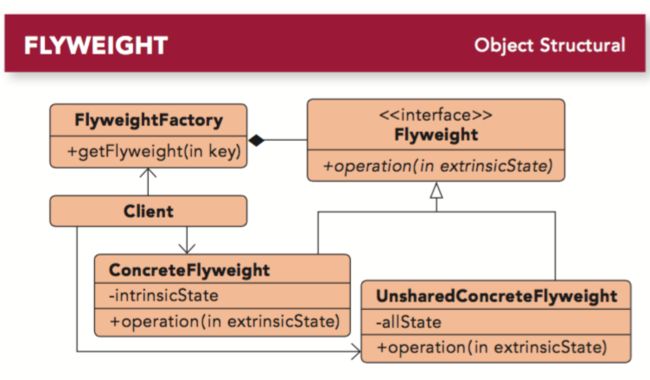享元模式
目的
服用小而多的对象,减少内存使用。
何时使用
- 对象太多消耗内存
- 大部分对象的状态是外在的(和对象本身无关)
- 用一些共享的对象代替大量对象
代码
http://codepen.io/staskh/pen/xEEwmN?editors=0010
首先看一个非享元模式,看看我们如何改进下面这个例子
/**
* Created by shenyin.sy on 17/3/23.
*/
var Book = function( id, title, author, genre, pageCount,publisherID, ISBN, checkoutDate, checkoutMember, dueReturnDate,availability ){
this.id = id;
this.title = title;
this.author = author;
this.genre = genre;
this.pageCount = pageCount;
this.publisherID = publisherID;
this.ISBN = ISBN;
this.checkoutDate = checkoutDate;
this.checkoutMember = checkoutMember;
this.dueReturnDate = dueReturnDate;
this.availability = availability;
};
Book.prototype = {
getTitle: function () {
return this.title;
},
getAuthor: function () {
return this.author;
},
getISBN: function (){
return this.ISBN;
},
// For brevity, other getters are not shown
updateCheckoutStatus: function( bookID, newStatus, checkoutDate, checkoutMember, newReturnDate ){
this.id = bookID;
this.availability = newStatus;
this.checkoutDate = checkoutDate;
this.checkoutMember = checkoutMember;
this.dueReturnDate = newReturnDate;
},
extendCheckoutPeriod: function( bookID, newReturnDate ){
this.id = bookID;
this.dueReturnDate = newReturnDate;
},
isPastDue: function(bookID){
var currentDate = new Date();
return currentDate.getTime() > Date.parse( this.dueReturnDate );
}
};
我们看到例子中的书本,关键的属性是
this.id = id;
this.title = title;
this.author = author;
this.genre = genre;
this.pageCount = pageCount;
this.publisherID = publisherID;
this.ISBN = ISBN;
和书本身无关的属性是
this.checkoutDate = checkoutDate;
this.checkoutMember = checkoutMember;
this.dueReturnDate = dueReturnDate;
this.availability = availability;
现在每次创建一个书本对象,都会创建上面的属性。
看看改进版。
// Flyweight optimized version
var Book = function ( title, author, genre, pageCount, publisherID, ISBN ) {
this.title = title;
this.author = author;
this.genre = genre;
this.pageCount = pageCount;
this.publisherID = publisherID;
this.ISBN = ISBN;
};
// Book Factory singleton
var BookFactory = (function () {
var existingBooks = {}, existingBook;
return {
createBook: function ( title, author, genre, pageCount, publisherID, ISBN ) {
// Find out if a particular book meta-data combination has been created before
// !! or (bang bang) forces a boolean to be returned
existingBook = existingBooks[ISBN];
if ( !!existingBook ) {
return existingBook;
} else {
// if not, let's create a new instance of the book and store it
var book = new Book( title, author, genre, pageCount, publisherID, ISBN );
existingBooks[ISBN] = book;
return book;
}
}
};
})();
// BookRecordManager singleton
var BookRecordManager = (function () {
var bookRecordDatabase = {};
return {
// add a new book into the library system
addBookRecord: function ( id, title, author, genre, pageCount, publisherID, ISBN, checkoutDate, checkoutMember, dueReturnDate, availability ) {
var book = BookFactory.createBook( title, author, genre, pageCount, publisherID, ISBN );
bookRecordDatabase[id] = {
checkoutMember: checkoutMember,
checkoutDate: checkoutDate,
dueReturnDate: dueReturnDate,
availability: availability,
book: book
};
},
updateCheckoutStatus: function ( bookID, newStatus, checkoutDate, checkoutMember, newReturnDate ) {
var record = bookRecordDatabase[bookID];
record.availability = newStatus;
record.checkoutDate = checkoutDate;
record.checkoutMember = checkoutMember;
record.dueReturnDate = newReturnDate;
},
extendCheckoutPeriod: function ( bookID, newReturnDate ) {
bookRecordDatabase[bookID].dueReturnDate = newReturnDate;
},
isPastDue: function ( bookID ) {
var currentDate = new Date();
return currentDate.getTime() > Date.parse( bookRecordDatabase[bookID].dueReturnDate );
}
};
})();
改进点在于,创建书本的时候,并不需要借书的信息,图书馆又可能又很多书,同样ISBN的书属性又都一样。
- 创建书的时候用ISBN
- 借书的时候用bookID
- 共享了相同书本身的属性,节约了内存。
技术上的例子
上面的设计模式是一个业务逻辑的例子,看看在我们日常使用的库中,有没有这样的思想。
可以看一下这个测评:
http://jsperf.com/jquery-fly/3
$("div").on( "click", function () {
console.log( "You clicked: " + $( this ).attr( "id" ));
});
// we should avoid using the DOM element to create a
// jQuery object (with the overhead that comes with it)
// and just use the DOM element itself like this:
$( "div" ).on( "click", function () {
console.log( "You clicked:" + this.id );
});
没必要每次都用DOM创建一个Jquery对象。
结论
其实UI库中往往有这个模式,像控件都有一些可以共享的属性,比如主题颜色等,有一些根据情况增加的属性,比如绑定的事件,名字等,所以在比较大的系统中,这个模式还是很有用的,能节省不少内存。
